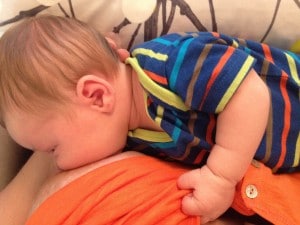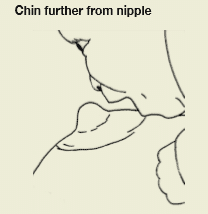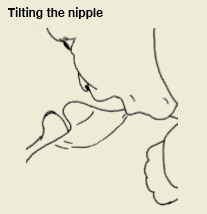Would a Baby Be Able to Get Some.milk From.breast With Tounge Tie
Are you lot experiencing pain while breastfeeding, peradventure combined with slow weight gain for your baby? While the vast majority of such breastfeeding issues tin be resolved past adjusting positioning and attachment, and with good breastfeeding management, occasionally tongue tie might exist the cause of the problem.
Tongue tie (ankyloglossia) is caused by a tight or short lingual frenulum (the membrane that anchors the natural language to the flooring of the mouth). The frenulum normally thins and recedes before birth. Where this doesn't happen, the frenulum may restrict tongue mobility. Tongue tie 
Breastfeeding challenges tin can also occur for other reasons. Identifying the cause is of import when deciding on appropriate solutions, and then seek help from someone skilled.
Identifying tongue necktie
When your infant tries to lift his tongue or move information technology forward it may appear misshapen, short or eye-shaped, with the frenulum clearly pulling its centre down and restricting its movement. Or you may be able to run across or feel business firm tissue where his tongue meets the floor of his mouth. Degrees of tongue tie vary and information technology can be difficult to diagnose accurately. A short, tight, posterior natural language tie is rarer, but may be specially hard to spot.
How breastfeeding may exist afflicted
Tongue tie affects natural language move to varying degrees. The shorter and tighter it is, the more probable information technology is to affect breastfeeding. Some babies with a tongue tie breastfeed well from the start, others do so when positioning and attachment are improved. Only any tongue tie that restricts normal tongue motility can pb to breastfeeding difficulties. A baby needs to exist able to movement his tongue freely and extend it over the lower gum with his mouth open up wide to exist able to breastfeed well. The symptoms below are all associated with poor attachment that may be acquired past tongue tie.
A infant may:
• Be unable to latch on to the breast at all.
• Be unable to latch on deeply, causing nipple pain and damage.
• Accept difficulties staying on the chest, making a clicking sound equally he loses suction.
• Splutter and choke when coping with fast flowing milk.
• Breastfeed constantly to become enough milk.
• Have poor weight gain or need supplementation to maintain adequate weight gain.
• Develop jaundice that needs treating.
• Be fussy at the breast when the milk flow slows.
• Develop colic.
A mother may experience:
• Pain during feeds, with damaged nipples. Her nipple may exist compressed or distorted into a wedge shape like that of a new lipstick immediately after feeding, oftentimes with a stripe at its tip.
• Engorgement, blocked ducts and mastitis because of ineffective milk removal.
• Low milk product because of ineffective milk removal.
• Oversupply—if her baby compensates for not being able to breastfeed well by nursing very frequently.
• Tiredness, frustration and discouragement.
• A premature terminate to breastfeeding.
Breastfeeding is important for every baby
Though sometimes needed as a temporary supplement if your milk production is very depression, introducing infant formula is not the answer. It has shortterm and long-term health risks for both your baby and you. A baby with tongue tie can also accept difficulties with bottlefeeding. Milk may leak from his oral cavity during feeds and he may suffer from colic.

Treatment
Where a natural language tie is causing breastfeeding issues, treatment options are available and effective— specially if the handling is prompt. Although attention to positioning and attachment can help maintain breastfeeding and improve comfort to a sure extent, at that place is show that treating tongue tie by frenotomy (encounter below) is effective in resolving breastfeeding difficulties. Weight proceeds can ameliorate dramatically. Too every bit the continued breastfeeding benefits, continuing to breastfeed after frenotomy maximises a babe'south chance of normal mouth (palate), speech and dental development. This includes natural language mobility for licking and moving particles of food around the oral cavity, helping prevent molar decay.
Keeping breastfeeding going
Mastering the fine art of breastfeeding can sometimes exist a claiming and it takes decision to keep going if y'all are in pain. The information here can aid you continue breastfeeding, both before and later handling.
Soften your breast
A infant with tongue tie may find it easier to latch on if your breast is soft so breastfeed oftentimes to avoid engorgement. When your baby bobs his head and licks the nipple, he naturally makes it easier to latch on. Or you tin use contrary pressure softening to move fluids away from the nipple surface area and then your infant can latch on well. Press all five fingertips of one paw around the base of the nipple. Utilize gentle steady pressure for about a infinitesimal to go out a ring of small-scale dimples on the areola. You can also printing with the sides of your fingers. Place your thumb on one side of the nipple and 2 fingers on the other side where your infant's lips will be. Gently mitt express a fiddling milk if needed.
Biological nurturing™
A baby ofttimes instinctively attaches more deeply and comfortably if he can snuggle up close to his mother's breast for periods of time. Try letting your baby prevarication on your body every bit yous recline and so both his chest and tummy are against y'all. This kind of 'laid-dorsum' breastfeeding contact is known every bit Biological Nurturing™ and tin be washed skin-to-pare or with you lot and your babe lightly clothed—whatever is more comfy and user-friendly for y'all both. Because gravity helps a baby keep his tongue forwards, this can make a real difference to how well your infant feeds and how much milk y'all make. See picture right and Online Information department for details of an online video.
A deeper latch
Help your babe get every bit deep a latch equally possible at the chest. This volition maximise the corporeality of milk he gets and minimise nipple pain.

If your baby retracts (pulls back) his tongue when he opens his mouth, try sliding his chin a little further from the nipple and so he can feel the 'fatter' function of the breast with his tongue. Denting the breast at the edge of the areola with a finger and placing your baby's chin in the dent may also help.

You could also try placing your pollex or finger nigh the base of the nipple where your babe's upper lip will exist. If you press, your nipple will tilt abroad from your baby, presenting him with your breast rather than your nipple. As he opens wide, snuggle him in close and use your thumb or finger to tuck the chest into his rima oris. Your nipple volition be taken in last and unroll in his rima oris. If needed, yous can then slip your finger out. An LLL Leader tin requite you further suggestions to help you better your baby's positioning and attachment
Encourage tongue mobility
To encourage your baby to move his tongue forward, yous can likewise try:
• Reclining with your baby on top of yous. Try leaning forward and back yourself to understand how gravity affects tongue position.
• Encouraging him to lick milk from his lips or from your nipple earlier and subsequently feeds.
• Sticking your tongue out at your baby to encourage him to copy you.
Maintain milk production
If your baby is sleepy or has jaundice, or if you have engorgement or inverted nipples, then a tongue necktie can make things worse. If he is not able to take enough milk directly at the breast and so you will need to express information technology and give it to your infant until he is able to breastfeed effectively. Express past hand and/or with a pump at least 8 times a day if your baby is non draining the breast well. This will maintain your milk production and ensure he gets enough milk.
Small-scale amounts of expressed milk can be offered by spoon, cup or syringe while yous both acquire how to breastfeed. Bottles or dummies tin can confuse your baby's sucking technique then consult an LLL Leader about breastfeeding friendly ways to bottlefeed or well-nigh using a nursing supplementer. This device delivers extra milk through a tube along your breast as your babe nurses, avoiding the need for bottles.
An unusual palate
Restricted tongue motility caused past natural language tie may bear upon the shape of a baby'southward palate, leading to a high palate or a bubble palate with a high spot. These may be a factor in cleaved suction, a clicking sound and pain during breastfeeding. A babe with an unusual palate may also resist a deeper latch due to gagging.
The following may assistance.
• Starting time with a clean finger with closely trimmed nail.
• Touch your baby'south lips and wait until he opens his mouth.
• Gently slide in your finger, pad side upward forth his hard palate, stopping just earlier the gag reflex is triggered.
Make this a pleasant game and, over a few days, gradually movement your finger back to overcome sensitivity. After a tongue tie is divided, a baby's increased tongue movement helps the palate shape become more than normal
Treating Natural language Tie
What tin be done?
Frenotomy—dividing the tongue tie—can dramatically better breastfeeding condolement and efficiency for both mother and infant. Dividing a tongue necktie is a quick and uncomplicated procedure. No anaesthetic is needed for a baby under half dozen months of historic period.
At that place are health professionals around the UK who have been specifically trained to divide tongue ties. For treatment on the NHS, you will demand a referral from your midwife, health visitor or GP. Knowledge nearly natural language ties and how they affect breastfeeding varies, so it is worth persisting and seeking a second opinion. In areas where merely GPs can refer, your midwife or health visitor may be able to give a recommendation to your GP or suggest seeing a particular GP. Private treatment may as well be an selection. Encounter Further Reading for data on finding a practitioner trained to divide natural language ties
Is waiting an option?
Sometimes a very sparse tongue necktie breaks spontaneously or tin can be stretched past gentle massage of the frenulum. The earlier a tongue necktie is divided, the easier it is to resolve any breastfeeding difficulties. Dividing a tongue tie in a baby over six months old is also a more complicated procedure and usually requires a general anaesthetic.
Frenotomy—what will happen?
After the health professional person'south initial assessment, your baby will be swaddled and held (often past an assistant) so he stays still during the procedure, which simply takes a minute or two. The health professional lifts the tongue and divides the frenulum past cut it with a pair of circular-ended sterile pair of scissors or by cauterising it.
Does it hurt?
No anaesthetic is needed for a very young babe as having a tongue tie divided simply hurts a piffling, if at all. Some babies protest more at beingness swaddled than about the treatment. Others slumber correct through the process! You volition be asked to breastfeed your baby every bit soon equally the procedure is over, to offering comfort, clean the wound and get his natural language moving as soon as possible. The inside of a baby'south mouth heals very quickly. The only treatment normally needed is to breastfeed to continue the wound clean and keep his tongue mobile. At that place may exist a white patch under your infant's natural language, but this heals within 24 to 48 hours.
If things don't resolve
Unremarkably a mother notices an instant improvement in her condolement during breastfeeds. Sometimes information technology takes a calendar week or two for a baby to adjust to his tongue'south greater mobility. An older infant may observe information technology harder to adjust to increased tongue mobility and natural language exercises may be recommended. Occasionally a baby's frenulum needs dividing a second fourth dimension, commonly because the segmentation was not quite extensive enough the kickoff fourth dimension. If you suspect that the initial procedure has not resolved your baby's breastfeeding problems arrange some other consultation. Practice persist with finding solutions. If several factors are involved it can have fourth dimension and expertise to resolve the problem. An LLL Leader can suggest farther paths to explore and provide ongoing support.
Painful nipples
Using dissimilar feeding positions tin can help if breastfeeding is painful. Or utilise the position you find most comfy until your nipples heal. Bank check your baby's attachment afterwards in the feed—if he slips down your nipple, this may cause you pain. Reclining breastfeeding positions or actress support under your arms may aid.
Ask your LLL Leader about chest compression, which tin can aid your infant get more than milk quicker. An increment in milk flow may also help him breastfeed more effectively.
Hand express to stimulate milk flow before feeding. Or start on the least painful side, switching sides once your milk lets down. Hurting tin reduce milk period, leading to engorgement and mastitis. Ask your doctor, midwife or health company about using a suitable painkiller. Applying warmth and using gentle massage and relaxation exercises just before feeds tin can help milk to flow.
Moist wound healing
When the underlying problem is corrected, moist wound healing can help your nipples heal without scab formation. After each feed gently pat your nipples dry to remove surface wetness. Use a tiny smear of ultra pure modified lanolin to each nipple, dabbing information technology on rather than rubbing. Hydrogel pads without a cloth bankroll tin can also be used.
Blood from cracked nipples
Blood from croaky nipples is not harmful to your baby. You can keep to breastfeed whilst working to amend positioning and zipper.
If healing is slow
In one case your baby starts latching on well you should feel more comfortable and notice signs of healing within a few days. If non, visit your GP—sometimes a bacterial or fungal infection can prevent healing. Connected hurting may be a sign that treatment (or farther treatment) of your infant's natural language tie is needed.
Seek support
This is a time when the support of other mothers in your local LLL group can be invaluable. You can find your nearest Leader or by calling our Helpline.
Farther Reading
Find a natural language necktie practitioner in the NHS – Association of Tongue Tie Practitioners
Biological Nurturing™
Lactation Consultants of United kingdom
The Womanly Art of Breastfeeding. LLLI. London: Pinter & Martin, 2010: p63-81, 428-430.
Comfortable Breastfeeding
Engorged Breasts – Avoiding & Treating
Expressing Your Milk
Hand Expression of Breastmilk
My Infant Needs More Milk
Nipple Know-How
Nipple pain
Nursing Supplementers
Sleep Infant – Why and What To Do
Storing Your Milk
LLLI Resources
Tongue Tie & the Breastfed Babe
References
Hazelbaker, AK. Natural language-Necktie: Morphogenesis, Impact, Assessment and Treatment. Columbus, OH: Aidan and Eva Press, 2010.
Mohrbacher, Northward. Breastfeeding Answers Made Uncomplicated. Amarillo Tx: Hale Publishing, 2010.
Watson Genna, C. Supporting Sucking Skills in Breastfeeding Infants. Burlington, MA. Jones & Bartlett, 2012.
Geddes, DT. et al. Frenulotomy for breastfeeding infants with ankyloglossia: Upshot on milk removal and sucking mechanism as imaged by ultrasound. Pediatrics 2008; 12(1):e188–94.
Hogan, One thousand. Westcott, C. and Griffiths, M. Randomized, controlled trial of division of natural language-tie in infants with feeding problems. J Paediatr Child Wellness 2005; 41:246–50.
Hong, P. et al. Defining ankyloglossia: A instance series of anterior and posterior tongue ties. Int J Ped Otorhinolaryngology 2010; 74:1003–6.
Knox, I. Tongue tie and frenotomy in the breastfeeding newborn. Neoreviews 11 (ix) Sept 2010.
Miranda, BH. and Milroy, CJ. A quick snip—a study of the affect of outpatient tongue necktie release on neonatal growth and breastfeeding. JPRAS 2010; 63:e683–5.
NICE Guidelines
Watson Genna, C. And Coryllos, EV. Breastfeeding and tongue-necktie. J Hum Lact 2009; 25(1):111–ii.
You lot can buy this information in printed class from the LLLGB Shop.
Copyright LLLGB 2016
Source: https://www.laleche.org.uk/tongue-tie/
0 Response to "Would a Baby Be Able to Get Some.milk From.breast With Tounge Tie"
Post a Comment